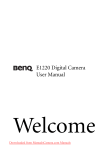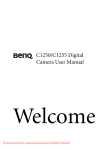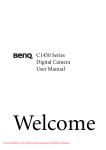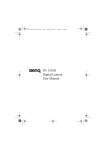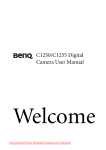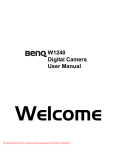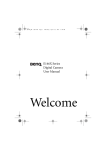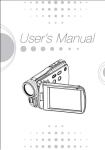Download BenQ DC E1020 Manual
Transcript
E1020 Digital Camera User Manual Welcome Downloaded from ManualsCamera.com Manuals Copyright Copyright 2008 by BenQ Corporation. All rights reserved. No part of this document may be reproduced, transmitted, transcribed, stored in a retrieval system or translated into any language or computer language, in any form or by any means, electronic, mechanical, magnetic, optical, chemical, manual or otherwise, without the prior written permission of this company. Disclaimer BenQ Corporation makes no representations or warranties, either expressed or implied, with respect to the contents hereof and specifically disclaims any warranties, merchantability or fitness for any particular purpose. Further, BenQ Corporation reserves the right to revise this document and to make changes from time to time in the contents hereof without obligation of this company to notify any person of such revision or changes. All other logos, products, or company names mentioned in this document may be the registered trademarks or copyrights of their respective companies, and are used for informational purposes only. Disposal of Waste Electrical and Electronic Equipment by users in private households in the European Union. This symbol on the product or on the packaging indicates that this can not be disposed of as household waste. You must dispose of your waste equipment by handing it over to the applicable take-back scheme for the recycling of electrical and electronic equipment. For more information about recycling of this equipment, please contact your city office, the shop where you purchased the equipment or your household waste disposal service. The recycling of materials will help to conserve natural resources and ensure that it is recycled in a manner that protects human health and environment. CE Regulatory Notice Hereby, BenQ Corp. declares under our responsibility that the product is in conformity with the requirements set out in the Council Directive on the Approximation of the Laws of the Member States relating, Electromagnetic Compatibility Directives (2004/108/EC) and Low Voltage Directive (2006/95/EC). A “Declaration of Conformity” in accordance with the above Directives has been made and is available from BenQ Corp. upon request. Downloaded from ManualsCamera.com Manuals FCC Statement This equipment has been tested and found to comply with the limits for a Class B digital device, pursuant to Part 15 of the FCC Rules. These limits are designed to provide reasonable protection against harmful interference in a residential installation. This equipment generates, uses and can radiate radio frequency energy and, if not installed and used in accordance with the instructions, may cause harmful interference to radio communications. However, there is no guarantee that interference will not occur in a particular installation. If this equipment does cause harmful interference to radio or television reception, which can be determined by turning the equipment off and on, the user is encouraged to try to correct the interference by one or more of the following measures: • Reorient or relocate the receiving antenna. • Increase the separation between the equipment and receiver. • Connect the equipment into an outlet on a circuit different from that to which the receiver is connected. • Consult the dealer or an experienced radio/TV technician for help. This device complies with Part 15 of the FCC Rules. Operation is subject to the following two conditions: (1) This device may not cause harmful interference, and (2) this device must accept any interference received, including interference that may cause undesired operation. FCC Caution: Any changes or modifications not expressly approved by the party responsible for compliance could void the user's authority to operate this equipment. Safety warning and notice Before operating the camera, please make sure that you read and fully understand the content in this section. If you ignore and violate all safety warning notices indicated in this section, the camera warranty may be void. Meanwhile, not only the camera but also you and all other people and things around you may be severely damaged, injured, or even placed in danger of death. • Keep the camera and its accessories out of the reach of babies, toddlers, and children. In particular, small parts such as memory cards and batteries could be easily dismantled and swallowed by them. • Use only the original accessories to avoid possible risks to health and property, and thus meet all related legal regulations. • Warranty is void if damage or system failure occurred due to outside factors such as collision, fire, flood, dirt, sewage, earthquake, and other Downloaded from ManualsCamera.com Manuals force majeure events as well as incorrect usage of electricity or use of non-original accessories. • It is the sole responsibility of the user if problems (such as data loss and system failure) occurred due to non-factory installed software, parts, and/or non-original accessories. • The only way of replacing the battery and the memory card is to open the Battery / Memory card cover. • Do not dismantle the camera under any circumstances. • The capacity of your camera battery will reduce each time it is charged/ emptied. Storage at too high or low temperatures will also result in a gradual capacity loss. As a result, the operating time of your camera may be considerably reduced, even after a full recharge of the battery. • Do not change the camera. Any changes to the camera invalidate the warranty. • When using the flash, do not go too close to human eyes (particularly for babies, toddlers, and children) or animal eyes. Otherwise, when the flash fires, the light may cause damage to human eyes or irritate animals. • Dispose of unwanted batteries and cameras as permitted by the laws in your countries. • Only use original batteries and charging devices. Otherwise you risk serious damage to health and property. The battery could explode, for instance. All batteries can cause property damage, injury or burns if a conductive material such as jewelry, keys or beaded chains touch exposed terminals. The material may complete an electrical circuit and become quite hot. Exercise care in handling any charged battery, particularly when placing it inside your pocket, purse, or other container with metal objects. Do not dispose of batteries in fire as they may explode. • Always keep the camera in the accompanying leather case or pouch for better protection against splashes, dust, and collision. Downloaded from ManualsCamera.com Manuals • The camera operating temperature is between 0 and 40 degrees Celsius. It is normal for the operating time to be shortened when the temperature is low. • Do not use or store your camera in the environments listed below: • Direct sunlight • Dusty places • Next to an air conditioner, electric heater or other heat sources • In a closed car that is in direct sunlight • Unstable locations • If your camera becomes wet, wipe it with a dry cloth as soon as possible. • Salt or seawater may cause severe camera damage. • Do not drop, knock, or shake the camera. A rude behavior of using the camera may damage the internal electronic circuit board, deform the lens shape, or make the lens unretractable. • Do not use harsh chemicals, cleaning solvents, or strong detergents to clean the camera. • Finger grease may be left on the camera lens and will result in unclear images or videos. To avoid this problem, be sure to clean the camera lens before taking pictures or recording videos. You should also clean the camera lens on a regular basis. • If the lens is dirty, use a lens brush or soft cloth to clean the lens. • Do not touch the lens with your fingers. • To prevent electric shock, do not attempt to disassemble or repair your camera by yourself. • Water may cause a fire or electric shock. Therefore, store your camera in a dry place. • Do not use your camera outdoors when it is raining or snowing. • Do not use your camera in or near water. • If a foreign substance or water gets in your camera, please turn the power off immediately and disconnect the battery and the power Downloaded from ManualsCamera.com Manuals adapter. Next, remove the foreign substance or water and send it to the maintenance center. • Whenever there is data in the internal memory or the external memory card, you should make a backup copy to a computer or disc. So, you can have a backup solution if data loss occurs. • If the lens cannot retract into the camera, please replace the battery first (usually this is because of a drained battery). Then the lens should retract automatically. If the lens still cannot retract, please contact your dealer. • Under no circumstances should you push the lens back manually as this may damage the camera. • Some camera models accepts non-rechargeable batteries. When using these batteries, do not charge them. Otherwise, dangers such as explosion and fire may occur. • All original accessories are designed only for use with this camera model you purchased. Do not use these accessories to other camera models or cameras of other brands to avoid unpredictable danger or damage. • It is normal for the camera to become warm during operation, because the camera casing can conduct heat. • Before initial use of a memory card, always format the card first using the camera. • Remember to slide the write-protect tab (if available) to the unlock position. Otherwise, all data (if any) on the memory card is protected and the card cannot be edited or formatted. Downloaded from ManualsCamera.com Manuals Table of Contents Touring the camera ................................................. 1 Checking the package contents .......................................1 Camera: front view and bottom views ......................................... 1 Camera: rear view ......................................................................... 2 Preparing the camera for use .................................. 2 Charging the battery ........................................................3 Using multifunctional buttons ........................................4 Using a memory card .......................................................4 Initial setting ............................................................ 5 Setting language ...............................................................5 Setting date and time .......................................................5 Operating the camera .............................................. 5 Digital Zoom ....................................................................6 Battery status ....................................................................7 Scene mode .......................................................................7 Movie Record mode settings ........................................................ 9 Flash mode ........................................................................9 Macro mode ...................................................................10 Drive mode .....................................................................10 Capture mode ........................................................ 11 Resolution .......................................................................12 Quality ............................................................................12 AF Area ...........................................................................13 Face Tracking .................................................................14 EV Compensation ..........................................................14 Auto Exposure Bracketing (AEB) ..................................14 Downloaded from ManualsCamera.com Manuals English Table of Contents Table of Contents English White Balance .................................................................15 ISO ..................................................................................15 Metering .........................................................................16 Effect ...............................................................................16 Setting Sharpness, Saturation and Contrast .................17 Setting menu .......................................................... 17 Playback mode ....................................................... 19 Options for playback and editing ..................................20 Enlarging an image ..................................................................... 20 Viewing multiple files at a time ................................................. 20 Deleting files ................................................................................ 20 DPOF ........................................................................................... 20 Slideshow .................................................................................... 21 Resize ........................................................................................... 21 Rotate .......................................................................................... 21 Protect ......................................................................................... 21 Divide (for videos only) ............................................................. 22 Move ............................................................................................ 22 Red-eye Removal ........................................................................ 22 Startup Image .............................................................................. 23 Working with computer and AV system .............. 23 Bundled software ............................................................23 Connecting the camera to a computer .........................23 Connecting the camera to an AV system ......................24 Printing images ..............................................................24 Printing with PTP ....................................................................... 24 Troubleshooting and service information ............ 25 Technical support ..........................................................26 Specifications .......................................................... 27 Downloaded from ManualsCamera.com Manuals Touring the camera 1 Checking the package contents Carefully unpack your kit box and ensure that you have the following items. ( ) 1. User Manual / Quick Guide 2. Digital camera 3. Battery 4. Hand strap 5. Pouch / leather case 6. Software & User Manual CD 7. Power adapter 8. 2-in-1 USB and AV cable • All images, screen captures, and icons used in this manual are for illustration only. Actual and available products, accessories, as well as their appearance may vary depending on sales region. • If any items are missing or damaged, contact your dealer. • Save the packaging for future shipment or storage. Camera: front view and bottom views 1. Shutter button 2. Power button / Status LED indicator) 3. Flash 4. Self-timer LED indicator 5. Battery / Memory card cover 6. Microphone 7. Lens 8. Power jack 9. Speaker 10. USB / AV port 11. Tripod mount Downloaded from ManualsCamera.com Manuals English Touring the camera 2 Preparing the camera for use Camera: rear view English 1. LCD display 2. W (Wide) - Zoom-out or thumbnail view (Playback mode) 3. T (Tele) - Zoom-in 4. Strap eyelet 5. Playback mode button - Toggle between Capture and Playback modes) 6. MENU button (for entering or exiting menu) 7. Multifunctional buttons (including a 4way control) plus an button (for entering or exiting a setting) 8. Scene mode • It is normal for the camera to become warm during operation, because the camera casing can conduct heat. • The LCD display on this camera is manufactured with sophisticated technology, and more than 99.99% of the pixels on the LCD display meet standard specifications. Yet, it is possible that less than 0.01% of the pixels on the LCD display may have some light spots or show unusual colors. This is normal and does not indicate display malfunction, nor will this affect the pictures you take with the camera. Preparing the camera for use Use only the specified battery for the camera, and always turn off the camera before removing the battery. A To install the battery: 1. Open the battery cover (A). 2. Insert the battery in the correct direction by matching the + - label on the battery cover (B). 3. Push the battery all the way down, until the battery lock lever clicks into place (C). 4. Close the battery cover (D). B Downloaded from ManualsCamera.com Manuals Preparing the camera for use 3 1. 2. 3. 4. Open the battery cover. Press and hold the battery. Release the battery lock lever. When the battery has come out a little, gently pull it out the rest of the way. 5. Close the battery cover. D Charging the battery The battery charge status affects the camera performance. To maximize the performance and the battery life, fully charge the battery using the camera and the specified power adapter, and then fully discharge it through normal use (at least once). To charge the battery: 1. Turn off the camera. 2. Insert the battery into the camera. 3. Connect one end of the power adapter to the camera. 4. Connect the other end of the power adapter to a wall outlet. The battery will start charging immediately. • Turn off the camera before removing the battery. • Please fully charge the Li-ion battery before using it for the first time. • When the battery is being charged, the status LED indicator flashes in blue. When the battery is fully charged, it turns off. • Use only the specified battery type. Using other types of battery may damage the camera and invalidate the warranty. • Ensure that the Li-ion battery is inserted into the product with correct polarity. Incorrect polarity may damage the camera or cause fire. • Download all pictures and remove the battery from the camera if you are going to store the camera for a long time. • Damage caused by the use of an incorrect power adapter is not covered under the warranty. • The battery may be warm after being charged or used. This is normal and not a malfunction. • When using the camera in a cold environment, keep the camera and its battery warm by holding it inside your jacket or another warm protective environment. Downloaded from ManualsCamera.com Manuals English To remove the battery: C 4 Preparing the camera for use Using multifunctional buttons You can choose camera settings by pressing the 4-way control or the button. English 1. Left/Macro/Auto Focus: • Scrolls left in menus. • Activates Macro mode or Auto Focus mode. • Press to fast rewind video playback. 2. Up/Flash: • Scrolls up in menus. • Selects a flash mode. 3. Right/Drive: • Scrolls right in menus. • Selects a drive mode. • Press to fast forward video playback. 4. Down/Info: • Scrolls down in menus. • Toggles between different information display modes. 5. • • • • : Confirms a chosen setting. Turns on/off Super Shake -Free (S.S.F.; available only in the Auto mode). Press to start and pause the video playback. Press to stop the voice memo playback. Using a memory card The camera comes with internal memory for storing captured images, video clips, or audio files. You can also add a memory card to store more files. To install a memory card: 1. Make sure the camera is turned off. 2. Open the memory card cover. 3. Insert a memory card in the correct direction. 4. Close the memory card cover. To remove a memory card: 1. 2. 3. 4. Make sure the camera is turned off. Open the battery cover. Press lightly the edge of the memory card to eject. Close the battery cover. Before initial use of a memory card, press > > Memory Card to format the card first. Downloaded from ManualsCamera.com Manuals > > Format > Initial setting 5 Initial setting Setting language Language Selects the language version shown on the screen. English To select a language: Español Français 1. Press > > Language > . (Step 1 is skipped when you first time use the camera.) 2. Press , or to locate the language you want. 3. Press English You will be prompted to set up the language and the date and time when the camera is turned on for the first time. Deutsch Français Italiano Italiano Español . Setting date and time Date & Time When first time using the camera or the battery has been removed from the camera for a long time, you need to set the date and time. They are used to record when a file was captured. 2008 / 10 / 23 19 : 45 To set date and time: 1. Press > > Date & Time > Press OK when done . 2. Press or to move between different column, and press proper number for each column. 3. Press or to select the . Operating the camera The procedure below is a general guideline for basic operation. It is particularly useful if you are new to the camera. 1. Press to turn the power on. 2. Press 3. Press > or or to select a tab ( or ). to locate a desired option, and then press (or Capture mode only) to make selections. (You can also press , or to locate a desired scene mode. Next, press ; available in the and use , to select and enter the mode.) At any time, you can cancel the current operation by pressing . 4. Press to zoom-in or to zoom-out. (In the Movie Record mode, you can still adjust the digital zoom while recording.) 5. Press the shutter halfway to set automatic focus. Once the focus is set, the focus frame color will turn from white (unfocused) to yellow-green (focused). Downloaded from ManualsCamera.com Manuals , 6 Operating the camera English If the focus frame color turns to red instead of yellow-green, then the automatic focus is not completed. This situation can happen for many reasons (for example, the subject is too dark). If you encounter this situation, release the shutter and see if you can find a better shooting environment. Then, try Step 5 again. 6. Press the shutter down fully to capture. 7. Release the shutter. 8. In the Movie Record mode, press the shutter to stop video recording. 9. Press to view captured images or recorded Digital Zoom videos, and then press , or to move to different images/videos. You can also press or Optical Zoom to zoom-in/out a captured image, or press to view 9 images on the screen. • During zoom-in/out, there is a separator in the zoom bar between and best image quality, it is recommended to use optical zoom only by keeping the magnification within and the separator. • Anytime in the Playback mode, you can press • At any time, you can press to switch to the Capture mode. to turn off the camera. • In Capture or Playback mode, press screen. to decide what information to show on the Digital Zoom This feature controls the digital zoom mode. Icon Mode Description Digital Zoom Turns on the digital zoom feature. OFF Turns off the digital zoom feature. To select a digital zoom: 1. Press > 2. Press > 3. Press > > Digital Zoom. or . For to select On or Off. Downloaded from ManualsCamera.com Manuals Operating the camera 7 Battery status Description English Icon Battery power is full. Battery power remains adequate. Battery power is low. Battery power is very low. You should replace the battery ASAP. Scene mode Select one of the following scene modes to fit your shooting condition. Icon Mode Description Auto The camera automatically decides most settings, so you can capture images with ease. Program You can set the shooting parameters manually. Aperture Priority You can choose an aperture value, while the shutter speed is automatically determined by the lighting condition of the subject. Shutter Priority You can choose a shutter speed, while the aperture value is automatically determined by the lighting condition of the subject. Movie Record Captures videos with sound. When viewing the captured video file later, you can see a unique icon that appears on the screen and indicates that this is a video file. Smile Catch Automatically takes a shot when a smile is detected. Portrait Makes the subject (usually a person) stand out with smooth and natural-looking skin tones. Landscape Captures a scene in the distance with the focus area set to infinity and a lower aperture value. The maximum depth of view can be also achieved. Sport Uses a high shutter speed to capture objects in motion. Backlight Increases exposure (by turning on the flash) when light illuminates the subject from behind. Night Scene Captures photos in a low-light environment, such as in the evening or at night. Beach Captures photos in a brightly lit environment, such as beaches. Downloaded from ManualsCamera.com Manuals 8 Operating the camera English Snow Used under a very bright light environment such as snow scenes. Fireworks Adds exposure time to shoot firework trails. Please keep the camera steady or use a tripod while using this mode. Night Portrait Shoots night scenes and portraits clearly. Please keep the camera steady or use a tripod while using this mode. Sunset Captures the warmth and atmosphere of sunrise or sunset. Museum Used when taking a picture of subjects in a place where flash is usually prohibited. Flash is always off. Party Captures the party atmosphere usually under indoor light source. Text Improves clarity & contrast when taking a close-up picture of documents. Kids & Pets Increases sensitivity and emphasizes children's skin tones or shows pets’ correct fur colors. Foliage Takes a clear and vivid picture of plant leaves by emphasizing their saturation and sharpness. Aquarium Takes a picture of the subject in an aquarium. Voice Rec. Captures background sound only (no images or videos). When listening to the captured audio file later, you can see a unique icon that appears on the screen and indicates that this is an audio file. For some scene modes like Auto, options ISO, Metering, and White Balance are not available. You must select another mode like Program to enable these options. To select a scene mode: 1. Press 2. Press > , , , or to locate a desired scene mode. . (For Aperture/Shutter Priority only) Press shutter speed, and then press > / to select an aperture value or . Downloaded from ManualsCamera.com Manuals Operating the camera 9 Movie Record mode settings Description Video Format: VGA (640 x 480), QVGA (320 x 240) White balance: Auto, Daylight, Tungsten, Fluorescent, and Cloudy. See "White Balance" on page 15 for more details. Effect: Vivid, Normal, B&W, Sepia. See "Effect" on page 16 for more details. • See "Setting Sharpness, Saturation and Contrast" on page 17 for information on saturation and contrast. • Sharpness is not available in the Movie Record mode. • Flash is automatically turned off in the Movie Record mode. • The Movie Record mode records both sound and video. The recording time is continuous, but recording will stop once the memory card space is full. • The zoom function is still available while a video is recording. See "Specifications" on page 27 for details. Flash mode The flash offers an additional light source (usually used in a low-light environment). You can capture an image using one of the following flash modes. Icon Mode Description Auto flash The flash fires automatically based on the photographic conditions. Force off The flash does not fire. Select this mode when flash photography is prohibited, or when the distance to the subject is beyond the effective range of the flash. Force on The flash always fires regardless of the surrounding lighting conditions. Select this mode when capturing images with high contrast (backlighting) and deep shadows. Auto anti red-eye Reduces the red-eye phenomenon when capturing natural-looking images of people and animals in low-light conditions. Be sure to ask the subject to look at the camera lens or get as close to the camera as possible. The flash fires automatically based on the photographic conditions. To select a flash mode: 1. Go to the Capture mode. 2. Keep pressing to toggle among different flash modes and select a desired option. Downloaded from ManualsCamera.com Manuals English Icon 10 Operating the camera Macro mode Icon Mode Description English Auto focus Adjusts focus automatically. Macro Used when capturing images at a close distance. To select Macro mode: 1. Go to the Capture mode. 2. Keep pressing to toggle between Auto focus and Macro modes. Drive mode Icon -- Mode Description Standard Takes one picture at a time. Self-timer Automatically takes a picture after 2 or 10 second delay. This mode is useful when you want to be part of the picture. Burst Continuously takes pictures as long as you keep pressing the Shutter. The flash is always off in this mode. M-Burst Takes thumbnail shots (each shot at the VGA quality ) into one single image in the number of 2 x 2 (4 shots), 3 x 3 (9 shots), or 4 x 4 (16 shots). This function is useful when you want to capture a continuous motion like swinging a golf club. The flash is always off in this mode. To select a drive mode: 1. Go to the Capture mode. 2. Keep pressing until the corresponding mode icon shows on the screen. To use M-Burst: 1. Go to the Capture mode. 2. Press > > M-Burst. 3. Press > Interval, and then select an interval time. 4. Select Shots, and then choose the number of total shots. 5. Select Exit and press 6. Press . 7. Keep pressing . until the corresponding mode icon shows on the screen. Downloaded from ManualsCamera.com Manuals Capture mode 11 English Capture mode 224 P 11 OK: Select 17 Item 12 18 Description Page reference 1 Scene mode 7 2 Flash mode 9 3 Focus mode 10 4 Drive mode 10 5 AEB 14 6 S.S.F. (available in the Auto mode only) 5 7 Resolution 9 8 Number of shots available -- 9 Quality 12 10 Zoom bar 5 11 AF area 13 12 Av (Aperture Priority) / Tv (Shutter Priority) selection (available in the Av / Tv mode only) 14 13 Battery status 14 14 Histogram -- 15 Exposure value (EV) 14 16 Metering 16 17 White Balance 15 18 ISO 15 Downloaded from ManualsCamera.com Manuals 12 Capture mode English • The above screen is for illustrations only. Actual items showing on the screen may vary depending on the scene mode you select. • In the Capture mode, press to toggle among 4 display modes (standard, complete, none, and rule of thirds). Use the rule of thirds display mode to improve your composition by placing subjects on at least one of the intersections of these 4 imaginary lines. • While the shutter is pressed down halfway, the AF area color changes to yellow-green, camera shake warning (appears only if the camera itself detects possible shaking), aperture, shutter speed and ISO setting are also shown on the screen. Resolution Icon Description Icon Description 10 megapixels (3664 x 2748) 3 megapixels (2048 x 1536) 3:2 (3664 x 2442) 16:9 (1920 x 1080) 8 megapixels (3264 x 2448) 2 megapixels (1600 x 1200) 5 megapixels (2576 x 1932) VGA (640 x 480) To select a resolution: 1. Press 2. Press > or > Resolution. . 3. Press or 4. Press 5. Press to confirm setting. . to select a setting. Quality Icon Mode Description Super Fine Best image quality with the lowest compression rate. File size is the largest. Fine Better image quality with medium compression rate. File size is medium. Normal Good image quality with the highest compression rate. File size is the smallest. To select an image quality level: 1. Press 2. Press 3. Press > or > Quality. . or to select a setting. Downloaded from ManualsCamera.com Manuals Capture mode 13 to confirm setting. . AF Area Icon Mode Description Multi Focuses on a wide range of multiple objects. Center Focuses on the center area of the objects. Selected Area (available in Focuses on the region you selected. the Program mode only) To select an automatic focus area: 1. Press > > AF Area. 2. Press or 3. Press or . 4. Press 5. Press to confirm setting. . to select a setting. To use Selected Area as the automatic focus area in the Program mode: 1. Press > 2. Press > > AF Area. 3. Press or . 4. Press or 5. Press 6. Press to confirm setting. . 7. Press and the 4-way control to choose a selected area from 9 available points. 8. Press to confirm setting. , and then select . Downloaded from ManualsCamera.com Manuals English 4. Press 5. Press 14 Capture mode Face Tracking English While Face Tracking is on, point the camera to where the people (your subjects) are located. Focus frames of face tracking will automatically detect faces (maximum 10) and show on the LCD screen. Then press the shutter to capture the image. To turn on/off Face Tracking: 1. Press > 2. Press or 3. Press or > Face Tracking. . to select a setting. 4. Press to confirm setting. 5. Press . • Due to environmental factors such as lighting, the number of detected faces might be different from that of the actual faces. • To achieve the best result, ask your subjects not to turn their faces partially away from the lens. EV Compensation Lightens or darkens the entire image. Adjust EV when the brightness between the subject and the background is not balanced, or when the subject occupies only a small part of the picture. To select an EV: 1. Press 2. Press > or > EV Compensation. . 3. Press or 4. Press 5. Press to confirm setting. . to select a setting. Auto Exposure Bracketing (AEB) The AEB function automatically takes 3 pictures with slightly different settings in the shutter speed or the aperture value. To turn on AEB: 1. Go to the Capture mode. 2. Press 3. Press > / to select On. > / to select an AEB bracket value. 4. Press 5. Press 6. Press > AEB. > . . Downloaded from ManualsCamera.com Manuals Capture mode 15 Compensates for color temperatures in different lighting conditions, so white and other colors can display properly when you capture images. Icon Mode Description Auto Adjusts white balance automatically. Daylight Used in bright daylight conditions. Tungsten Used when subjects lit by tungsten (incandescent) lighting. Fluorescent Adjusts for fluorescent lighting. Corrects the green hue of fluorescent lighting. Ideal for indoor photos under fluorescent lighting without a flash. Cloudy Used in twilight or shady conditions. To select white balance: 1. Press > > White Balance. 2. Press or 3. Press or . 4. Press 5. Press to confirm setting. . to select a setting. ISO ISO configures the camera’s sensitivity to light. The higher the ISO value, the brighter picture you can take in a low-light environment. Yet, you may see more noise in the picture as you increase the ISO value. Icon Description Automatically sets the ISO value. Equivalent to color ISO 80/100/200 film. Used for outdoor photography in bright sunlight. Equivalent to color ISO 400/800/1600 film. Used it in a low-light environment or where the flash light is not allowed. To select an ISO value: 1. Press > 2. Press or 3. Press or > ISO. . to select a setting. Downloaded from ManualsCamera.com Manuals English White Balance 16 Capture mode 4. Press 5. Press to confirm setting. . English Metering Icon Mode Description Matrix Detects the exposure based on multiple points in the subject area. Spot Detects the exposure based on the center spot in the subject area. Average Detects the exposure based on the average reading in the subject area. To select an AE metering option: 1. Press > > Metering. 2. Press or 3. Press or . 4. Press 5. Press to confirm setting. . to select a setting. Effect Adds color filter effects to the image or video you want to capture. Icon Mode Description Vivid Adds an effect with very clear and bright color tones. Normal No effects are added. Black and White (B&W) Adds an effect with monochromatic color tones. Sepia Adds an effect with dark reddish brown color tones, so the image or video looks as if it is old. To select an effect: 1. Press 2. Press > or > Effect. . 3. Press or 4. Press 5. Press to confirm setting. . to select a setting. Downloaded from ManualsCamera.com Manuals Setting menu 17 Setting Sharpness, Saturation and Contrast To set sharpness, saturation, or contrast: 1. Press > 2. Press or 3. Press or 4. Press > , and then select Sharpness, Saturation, or Contrast. . , and then select High, Normal, or Low. . Setting menu Press > , and then select an option. Option Description LCD Brightness Sets the degree of brightness for the screen. File No. Use this function if you want to restart numbering, for example, after erasing all files. • Reset: Resets file numbering each time the memory card is changed. • Series: Stores the latest used file number no matter deleting files or inserting a new memory card. This is useful for avoiding the file name duplication when images are downloaded to a computer. Digital Zoom See "Digital Zoom" on page 6. Instant Review This feature displays the still image that just recorded for 1 second. To set the Instant Review: 1. Press > > Instant Review. 2. Press or , and then select On or Off. 3. Press 4. Press to confirm setting. . Sounds Volume: Adjusts the volume of the shutter sound, startup sound, and beep sound. Startup: Sets a type of the start-up sound. Shutter: Sets the shutter sound on and off. LCD Saving Sets the idle time before the camera automatically enters the standby mode to save battery power. Power Off Adjusts the time before the camera automatically turns off while the camera is idle. TV Format Sets the video format (such as NTSC or PAL) when connecting to an AV system like TV. Downloaded from ManualsCamera.com Manuals English Adjusts how colors appear in the pictures by setting sharpness, saturation, and contrast. 18 Setting menu English USB Mode Sets the transfer method between the camera and a computer. • PTP: Used when the camera is connected to a Pictbridge-compatible printer via a USB cable. • MSDC (default): The camera acts as a mass storage device providing file transfer between the camera and a computer. Date Stamp Imprints the date when a picture was taken on the picture itself. To set the date stamp: 1. Press > > Date Stamp. 2. Press or 3. Press or . 4. Press 5. Press to confirm setting. . to select a date format. Date & Time Sets date and time and date format. Language Sets the displayed language on the screen. Image Storage Sets where images and videos are stored. • Auto: Sets the external memory card as the first priority location to store files. • Internal Memory: Sets the memory built-in the camera as the location to store files. Format Formats the internal memory or the memory card. Reset Returns all settings to the factory default values. Voice Memo Sets whether to record voice memos after pictures are taken (available in the Playback mode only). Version Shows the current camera firmware version number. Downloaded from ManualsCamera.com Manuals Playback mode 19 Playback mode to enter the Playback mode. 2008/08/06 17:48:44 English Press 24/131 IMGOO24.JPG 2.37 MB 1/40 F2.9 P • The above screen is for illustrations only. Actual items showing on the screen may vary depending on the file type and the settings you chose while capturing. • In the Capture mode, press to enter the Playback mode. • In the Playback mode, press to switch to the Capture mode. • (Used when the camera is off) While pressing and holding , press to enter the playback mode. • While pausing video playback, you can press the shutter to capture the video frame as a still image in the VGA format. Item Description Page reference 1 Indicates that the camera is in the Playback mode. 2 Indicates this file has a voice memo. --- 3 Indicates that the file is protected and cannot be deleted. 21 4 Indicates the file is marked for printing. -- 5 Displays the following information and controls: • the shooting conditions such as scene mode and image size. • Lets you rotate or add voice memo. • Shows whether it is a video file and the play button. -- You can press to toggle between different information and controls. 6 Date and time when the file was created. 7 Current file number / total number of files -- 8 Histogram -- 9 File name, file size, shutter speed, and F. No. -- Downloaded from ManualsCamera.com Manuals -- 20 Playback mode Options for playback and editing English When the camera is in the Playback mode, press can also select any of the following options. , or to move to different files. You Enlarging an image Magnifies an image, so more details can be seen. To enlarge an image: 1. Press . 2. Press , or 3. Press to zoom-in or to move to the image you want to enlarge. 4. Press , , , or to zoom-out. to move to the area you want to see. 5. (Optional) If you want to crop the image, press the screen. and follow the remaining instructions on Viewing multiple files at a time Shows up to 9 files at a time on the screen. To view multiple files: 1. Press > . 2. Maximum 9 files (shown in thumbnails) are displayed on the screen. Press or to select a file, and then press , , , to view it in its normal viewing size. Deleting files Removes selected or all files. To delete files: 1. Press > and move to the image/video file you want to delete. 2. Press and select whether to delete this selected file or all files, then press . DPOF The Digital Print Order Format (DPOF) setting allows you to select images on the memory card for printing and specify the number of print copies in advance using the camera. This is extremely convenient for sending the images to a photo developing service or for printing on a direct print function compatible printer. To set up DPOF: 1. Press > > > DPOF > . 2. Select This image (or All images if you want to set DPOF to all image files), and then press . Press or to select the image you want to print out, and then press specify the number of copies. Downloaded from ManualsCamera.com Manuals or to Playback mode 21 Slideshow To play a slideshow: 1. Press 2. Press > > > > Slideshow > > Interval > . to set the interval between 3 ~ 30 seconds, and then press . 3. Select Loop to decide whether to resume playback once the slideshow playback ends. 4. Select Start, and then press press to start the slideshow (to stop the slideshow at any time, ). Resize Changes an image file to a smaller size, and saves it as another new file. To resize an image: 1. Press > 2. Press or > to move to the image you want to resize. > Resize > . 3. Press or to select the target image size to which you want to reduce. 4. Press to save the resized image file to another new file. Rotate Changes the orientation of an image. To rotate an image: 1. Press > 2. Press or > to move to the image you want to rotate. > Rotate > . 3. Press to rotate the image counter-clockwise, or 4. Repeat step 3 until desired orientation is achieved. to rotate the image clockwise. 5. Select > OK > to save the file (the original file will be overwritten), or Exit if you do not want to rotate the image. Protect Prevents selected files from accidental removal. To protect files: 1. Press 2. Press 3. Press > or > to move to the image you want to protect. > Protect. . You will then see the icon indicating the file is protected. You can remove the protection anytime by following the same procedure as shown above. Downloaded from ManualsCamera.com Manuals English Presents a series of captured image and video files. 22 Playback mode Divide (for videos only) English This video trimming function, available in the playback mode when a video file is selected, extracts a portion from the original video. To use the Divide function: 1. Press > 2. Press > or 3. Keep pressing (starting frame) 4. Press to move to the video you want to divide. > or > Divide > . , and then keep pressing as the mark-out point (ending frame) 5. Press . until you move to the frame you want to set as the mark-in point to move to or until you move to the frame you want to set . , and then press to preview the trimmed video. 6. Press to move to , and then press to select one of the following options: • New file: saves the trimmed video as a new video file. • Overwrite: saves the change to the original video file. • Exit: cancels the trimming task. You can discard all trimming changes at any time by selecting and return to the previous menu. Move This function moves the currently selected image or all images from the internal memory to the unprotected memory card. This function is available when the camera is set to using the Internal Memory mode and a unprotected memory card is inserted, To use the Move function: 1. Press > > > Move > . 2. Select This image (or All images if you want to move all files), and then press 3. Press . . Red-eye Removal This function, available when an image was taken using the flash, tries to remove the redeye effect from the original image file. To use the Red-eye Removal function: 1. Press > > > Red-eye Removal > . 2. Select one of the following options: • New file: saves the image as a new image file. • Overwrite: saves the change to the original image file. • Exit: cancels the red-eye removal. 3. Press . Downloaded from ManualsCamera.com Manuals Working with computer and AV system 23 Startup Image To select a startup image: 1. Press > > > Startup. 2. Press or and then select one of the following options: • Off: No welcome image when you turn on the camera. • Default: uses the original startup image. • My photos: uses or to move to the image you want to use as the startup image. 3. Press . Working with computer and AV system Bundled software The camera offers the following programs on a CD. ArcSoft PhotoImpression 5 Combines photo editing with creative enhancement and sharing tools that maximize your digital media experience. ArcSoft VideoImpression 2 Creates multimedia presentations by combining photos and video clips with audio, text and scene transitions. To install these programs, see the information supplied with the CD. Connecting the camera to a computer You can connect the camera to a PC or notebook to transfer, view, print, or edit files. To connect the camera to a computer: 1. Connect the end of the smaller plug of the 2-in-1 USB and AV cable to the camera. 2. Connect the other end of the 2-in-1 USB and AV cable to an available USB port on your computer. 3. Turn on the camera. 4. A Removable Disk icon appears in My Computer. Click this icon to access the files in your camera. • When connecting the camera to a computer, it is necessary to install a battery into the camera. • When connecting the camera to a computer, please use the original accessory of the USB cable to avoid possible system conflicts and damage to the camera. Downloaded from ManualsCamera.com Manuals English Sets the welcome image when the camera is powering on. 24 Working with computer and AV system Connecting the camera to an AV system You can play files in your camera from an AV system such as TV or projector. English To connect the camera to an AV system: 1. Connect the end of the smaller plug of the 2-in-1 USB and AV cable to the camera. 2. Connect the yellow video plug and the white audio plug of the 2-in-1 USB and AV cable to a video-input jack and an audio-input jack (left channel) on your AV system. 3. Turn on the AV system, and then switch to the AV source connecting to the camera. 4. Turn on the camera. 5. Follow the on-screen instructions to operate the camera via the TV or projector screen. Printing images In addition to printing images by connecting the camera to a printer via a computer or bringing the memory card (if available) to a photo-processing center, you can choose to print using a PictBridge-compatible printer. Printing with PTP You can directly print images by connecting your camera to a PictBridge-compatible printer without using a computer. To print images from a PictBridge-compatible printer: 1. 2. 3. 4. 5. Set the USB Mode to PTP (See "USB Mode" on page 18 for details.) Connect the end of the smaller plug of the 2-in-1 USB and AV cable to the camera. Turn on the printer. Wait for a while until it finishes starting up and is ready to print. Turn on the camera. The Printer Connecting screen displays on the LCD display.The Print menu will then pop up automatically. 6. Press or to select an option. 7. Press and follow the remaining instructions on the screen. • The above procedure may vary depending on the printer type you are using. • If you connect the camera to your printer while the printer is still starting up, the camera will be automatically turned off. • Failure to follow the above procedure will make the camera show an error message. Please disconnect the camera and the camera will be automatically turned off. Downloaded from ManualsCamera.com Manuals Troubleshooting and service information 25 If your camera cannot operate normally, see the frequently encountered problems and solutions listed below. If the problem persists, contact your nearest service center or technical support. Problem The camera cannot power up. Cause The battery has no power. The battery power is draining quickly. Solution There is no battery or the battery is Insert the battery correctly. not inserted correctly. Recharge the battery. The external temperature is extremely low. -- Many shots are being captured in dark places, requiring a flash. -- The battery was not fully charged, Fully charge the battery and discharge it for at least one or it has not been used for an extended period of time after being complete cycle before use. charged. The battery or camera is warm. The camera or flash was used continuously over a long period of time. -- The flash does not The camera flash is turned off. fire or recharge. The light source is sufficient. Set the flash to Auto Flash. Even though the flash fired, the image is dark. The distance to the subject is greater than the flash's effective range. Get closer to the subject and shoot. The image is too bright or too dark. The exposure is excessive or inadequate. Reset exposure compensation. I cannot format a memory card. The memory card is writeprotected. Remove the write protection. I cannot download images from the camera to my computer. -- End of the memory card life. Insert a new memory card. The free space on the hard disk of your computer is insufficient. Ensure that the hard disk has enough space for running Windows and that the drive for loading image files has free space equal to or greater than the memory card in the camera. There is no power being supplied to the camera. Recharge the battery. Downloaded from ManualsCamera.com Manuals English Troubleshooting and service information 26 Troubleshooting and service information English The camera does not shoot even when pressing the shutter button. The battery is running low. Recharge the battery. The camera is not in the Capture mode. Switch to the Capture mode. The shutter button was not pressed Press the shutter button all the way all the way down. down. The internal memory or memory Load a new card or delete card does not have any free space. unwanted files. The flash is recharging. Wait until the flash mode icon, indicated on the screen, stops flashing. The camera does not recognize the Format the memory card before the memory card. initial use or before using with another camera. I cannot print The camera is connected to the images with printer when the camera is PictBridgepowered off. compliant printers. Turn on the camera, select PTP, and then connect to the printer. Technical support For technical assistance, free driver updates, product information, and news releases, visit the following web site: http://www.BenQ.com Downloaded from ManualsCamera.com Manuals Specifications 27 Sensor Sharp 10 Mega Pixels CCD Size: 1/2.33 inch Zoom Optical: 3X (not available in the Movie Record mode) Digital: 5X (capture) / 8X (playback; 2X for VGA images) Lens f = 5.7 (W) ~ 17.1 (T) mm (35mm film equivalent: 32 ~ 96 mm) F/2.9 (W) ~ 5.2 (T) Focus range Normal: 60cm ~ Infinity Macro: 10cm ~ 70 cm (Wide) LCD 2.7” 230K LCD Image resolution 10M (3664 x 2748) / 3:2 (3664 x 2442) 8M (3264 x 2448) / 5M (2576 x 1932) / 3M (2048 x 1536) / 16:9 (1920 x 1080) 2M (1600 x 1200) / VGA (640 x 480) Movie mode 640 x 480, 320 x 240, up to 30fps Continuous recording with sound Shutter speed 1/2000 ~ 2 sec White balance Auto / Daylight / Tungsten / Fluorescent / Cloudy Exposure -2 ~ +2 EV (0.3 EV/step) ISO Auto, 80, 100, 200, 400, 800, and 1600 Flash Auto / Force off / Force on / Auto anti red-eye Drive mode 2 sec / 10 sec / Burst / M-Burst Power source 700 mAh rechargeable Li-ion battery CIPA approx. 200 based on bundled Li-ion battery Storage type Built-in approx.10MB (usable) 16GB SD/SDHC card compatible File format DCF compatible DPOF supported Still image: JPEG (Exif 2.2. compatible) Audio: WAV Video: MJPEG Dimensions / Weight 93 x 58 x 21.5 mm (slimmest 20.2 mm) 120 g (without battery and SD card) Interface • Digital output: USB2.0 compatible • Audio/Video output (NTSC/PAL) • PictBridge-compatible Downloaded from ManualsCamera.com Manuals English Specifications 28 Specifications Accessories English User Manual / Quick Guide Li-ion battery Hand strap Pouch / leather case Software & User Manual CD Power adapter 2-in-1 USB and AV cable Battery retail pack: DLI-215 (optional) All information, designs, and specifications are subject to change without prior notice. Downloaded from ManualsCamera.com Manuals




































